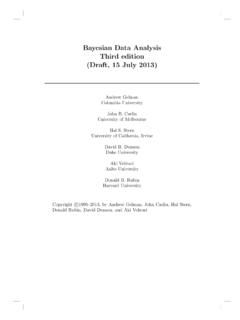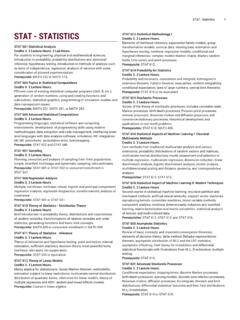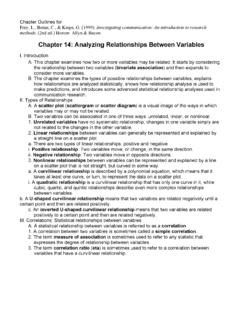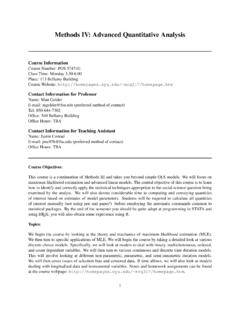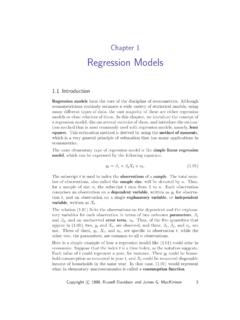Transcription of Real AdaBoost: Boosting for Credit Scorecards and ...
1 1 Paper 1323-2017 Real adaboost : Boosting for Credit Scorecards and similarity to WOE logistic regression Paul K. Edwards, Dina Duhon, Suhail Shergill ScotiabankABSTRACT adaboost is a machine learning algorithm that builds a series of small decision trees, adapting each tree to predict difficult cases missed by the previous trees and combining all trees into a single model. We will discuss the adaboost methodology and introduce the extension called Real adaboost . Real adaboost comes from a strong academic pedigree: its authors are pioneers of machine learning and the method has well-established empirical and theoretical support spanning 15 years. Practically speaking, Real adaboost is able to produce readable Credit Scorecards and offers attractive features including variable interaction and adaptive, stage-wise binning. We will contrast Real adaboost to the dominant methodology for creating Credit Scorecards : stepwise weight of evidence logistic regression (SWOELR).
2 Real adaboost is remarkably similar to SWOELR and is well positioned to serve as a benchmark for SWOELR models; it may even offer a statistical framework by which we can understand the power of SWOELR. We offer a macro to generate Real adaboost models in SAS. INTRODUCTION Financial institutions (FIs) must develop a wide range of models for marketing, fraud detection, loan adjudication, etc. Modeling has undergone a recent renaissance as machine learning has exploded spurned by the availability of advanced statistical techniques, the ubiquity of powerful computers to execute these techniques, and the well-publicized successes of the companies who have embraced these methods (Parloff 2016). Modeling departments within some FIs face opposing demands: executives want some of the famed value of advanced methods, while government regulators, internal deployment teams and front-line staff want models that are easy to implement, interpret and understand.
3 In this paper we review Real adaboost , a machine learning technique that may offer a middle-ground between powerful, but opaque machine learning methods and transparent conventional methods. CONSUMER RISK MODELS One field of modeling where FIs must often strike a balance between power and transparency is consumer risk modeling. Consumer risk modeling involves ranking customers by their Credit worthiness (the likelihood they will repay a loan): first by identifying customer characteristics that indicate risk of delinquency, and then combining them mathematically to calculate a relative risk score for each customer (common characteristics include: past loan delinquency, high Credit utilization, etc.). Credit Scorecards In order to keep the consumer risk models as transparent as possible, many FIs require that the final output of the model be in the form of a scorecard (an example is shown in Table 1).
4 Credit Scorecards are a popular way to represent customer risk models due to their simplicity, readability, and the ease with which business expertise can be incorporated during the modeling process (Maldonado et al. 2013). A scorecard lists a number of characteristics that indicate risk and each characteristic is subdivided into a small number of bins defined by ranges of values for that characteristic ( , Credit utilization: 30-80% is a bin for the Credit utilization characteristic). Each bin is assigned a number of score points, a value derived from a statistical model and proportional to the risk of that bin (SAS 2012). A customer will fall into one and only one bin per characteristic and the final score of the applicant is the sum of the points assigned by each bin (plus an intercept). This final score is proportional to consumer risk. The procedure for developing Scorecards is termed stepwise weight of evidence logistic regression (SWOELR) and is implemented in the Credit Scoring add-on in SAS Enterprise Miner.
5 2 Table 1 - A Hypothetical scorecard Characteristic Bin Score points Past loan delinquency No past loan delinquency 21 One past loan delinquency event 5 More than one past loan delinquency event 0 Credit utilization Low Credit utilization (<30%) 25 Medium Credit utilization (30-80%) 10 High Credit utilization (>80%) 0 STEPWISE WEIGHT-OF-EVIDENCE LOGISTIC regression (SWOELR) Generating a scorecard requires binning characteristics and then weighting each bin of each characteristic to estimate the appropriate number of score points for the bin. Typical consumer risk models predict whether a customer will become delinquent over a fixed period of time, expressed as a binary target variable, {0,1}. The modeler can provide a set of j predictor variables ( , past loan delinquency, high Credit utilization, etc.), :{ ,1, ,2,.., , } so the data involved is a set of ( , ) observations for ={1,2.}
6 , } for some n number of customers. The first step is to bin each characteristic. This is done by growing a decision tree that uses Y as a target variable and one of the characteristics as an input. The process is repeated for each characteristic available. This results in one tree per characteristic, and each tree determines the bins for the characteristic. Each bin contains a fraction of all the Y=1 events we use this fraction to calculate the Weight-of-evidence (WOE) for one bin of one characteristic, , ( )= , =0 =0 , ( )= , =1 =1 WOE , =log( , ( ) , ( )) where WOE , is the WOE for the k-th bin of the j-th characteristic. The numerator in the WOE equation, , ( ) comprises , =0, the count of all Y=0 events in bin k (from a decision tree grown using characteristic j) and =0, the count of all Y=0 events total in the entire dataset. The denominator in the WOE equation, , ( ), comprises , =1, the count of all Y=1 events in bin k (from a decision tree grown using characteristic j) and =1, the count of all Y=1 events total in the entire dataset.
7 The WOE , ranges between ( , ) and is a metric of the purity of the bin with respect to the target value. A large negative value indicates that most Y=1 values in the training set occur in that bin and a large positive value indicates most Y=0 values occur in the bin. Calculation of WOE , ( , ) requires knowing which k bin the value , will fall into, from a decision tree grown using characteristic j. For notation, we introduce a new function ( , ) that sorts , into the appropriate k bin and outputs the WOE , value of that bin. When building a model in the Credit Scoring add-on in SAS Enterprise Miner each tree uses one and only one characteristic, but the above procedure works with multivariate trees as well. The next step is to weight each characteristic. Rather than weighting the raw variable directly, we weight the ( , ) value instead. The classical approach for binary problems of this sort is logistic regression , 3 which fits a coefficient (a weight) to each predictor value.
8 We can use logistic regression to fit weights to each of the binned characteristics. The motivation to use trees to bin variables before applying logistic regression is threefold: i) it deals with outliers and missing values, ii) it allows the linear models to capture non-linear relationships, and iii) it helps Credit modelers better meet business objectives (Siddiqi, 2012). ( ( =1))= 0+ ( , ) =1 In this equation, the terms weight the contribution of each ( , ) to the final estimate. The final estimate, ( ( =1)) is the logit of ( =1| ). Logistic regression allows us to select terms that minimize the error of our predictions. This task is handled by a numerical optimization routine which attempts to select terms that maximize the likelihood function ( | , ( )). It is common in risk modeling to add terms to this regression equation in a stepwise manner. In general, the stepwise procedure adds the strongest =1( , =1) characteristic first, and continues adding +1( , +1) terms until the model is no longer improved.
9 The score of each bin use in the scorecard is proportional to WOE , (Siddiqi, 2012). Figure 1 summarizes the steps to make a SWOELR model. The key to connecting SWOELR with Boosting methods is to understand that ( , ) is itself a predictive model of ( =1). A large negative value from of =1( , =1) indicates that this observation falls into a bin that has a lot of Y=1 events; based on this, a reasonable guess would be to label this observation =1. A single large negative value from =1( , =1) is weak evidence that our observation should be labeled =1 so we say that =1( , =1) is a weak estimator. If =2( , =2), =3( , =3) and several more of our Wj estimators all assign large negative values then taken together we have a strong estimator of . Adding together weak estimators to form a strong one is the motivation behind Boosting and SWOELR. Boosting : ADA AND REAL SWOELR is a way to weight and combine weak, tree-based classifiers into an additive equation.
10 The adoption of this strategy is likely the reason that SWOELR works well. A machine learning technique called Boosting was also developed to combine weak estimators into an additive equation. The method works for any kind of classifier but in practice trees are generally used; we consider only tree-based classifiers here. The Boosting methods we will introduce offer two differences from SWOELR: i) Boosting adaptively selects weak classifiers (the second tree is built to compensate for shortcomings in the first tree, rather than generating all trees ahead of time as with SWOELR) and ii) Boosting eliminates the need to numerically fit coefficients (weights) to each tree thus removing the logistic regression step of SWOELR. adaboost The first popular application of Boosting to binary classification problems was a procedure called adaboost (Freund & Schapire 1997), which follows a simple algorithm shown in Figure 2, 1.












